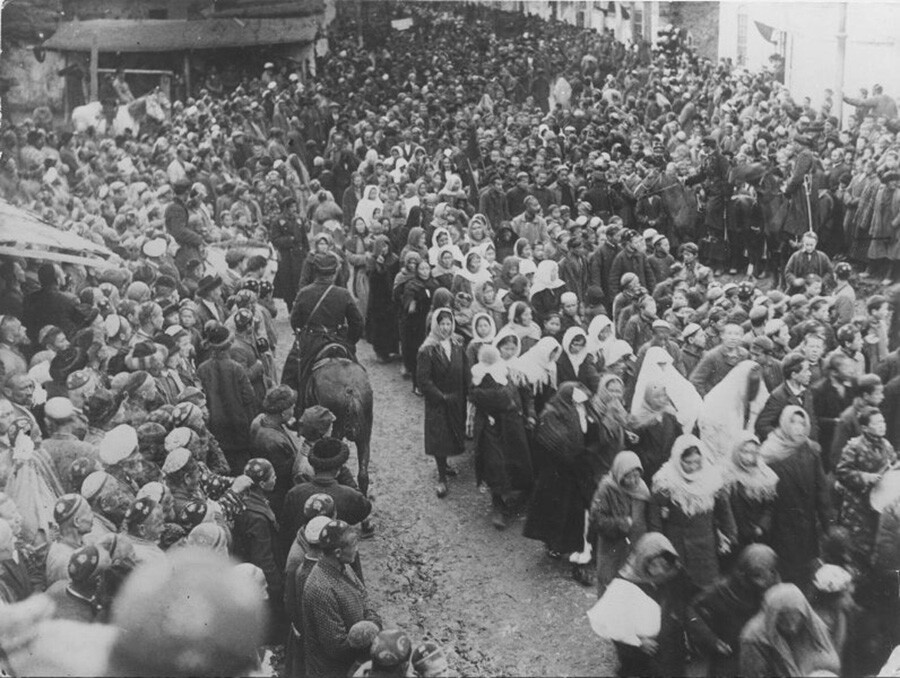
March 8 officially became a Soviet holiday in 1965, although the celebration appeared much earlier. Sociologist Pitirim Sorokin wrote the following about the events of 1917: “If future historians want to find out who started the Russian Revolution, they don’t need to engage in confusing theorizing. The revolution was started by hungry women and children, seeking bread.”

Demonstration of Petrograd workers on February 23 (March 8), 1917
MAMM/MDFIt was the St. Petersburg weaving factory strike on February 23, 1917 - lasting until March 8 - that really led to the fall of the Russian monarchy. The women participating in the unrest were destroying tram wagons and breaking store windows, demanding that worker rights be respected and the tsar overthrown.

International Women's Day March 8, 1924
Georgy Zelma/MAMM/MDFThe uprising gave birth to what we know as March 8 - or International Women’s Day - in the USSR. Different countries used to celebrate the fairer sex on different days, including March 2, 9 and 12, as well as May 2 and 12 in some places. However, the international socialist movement adopted the Soviet version. This way, in 1921, the USSR introduced the holiday.

At the performance of the physical fitness club in honor of March 8
Photos by users of russiainphoto.ruIn the following years, however, March 8 began steadily losing its revolutionary underpinnings, simply becoming a celebration of women as laborers, mothers and communists. The woman was portrayed as an object of Soviet pride and a symbol of socialist progress.

Demonstration of women on March 19, 1917
MAMM/MDFAnd the USSR did have a claim to pride: Following the February Revolution, women gained voting rights - a year earlier than in Britain and three years earlier than the United States. In so doing, they set an example for British and American suffragettes. However, it would not be long before these international activist ties were severed. The “female question” in the USSR was now a state matter and began to be addressed accordingly.

Celebration of March 8, 1938
MAMM/MDFMarch 8 began to be marked by celebratory gatherings at factories, where female workers would share their achievement as women working in industry. Further to that, as one Tver Region newspaper wrote: “March 8 is a day for the appraisal of female laborers and peasants.” In other words, women were encouraged to put in additional effort and exceed work quotas to mark the occasion: those that managed more than others were rewarded. Meanwhile, women remained in their role as primary domestic workers, performing all the chores.

Gift store prepares showcase for March 8, 1967
Isaac Tunkel, Dmitry Ukhtomsky/MAMM/MDF/Russia picturedThe emphasis on that began to change in the 1950s, according to historian Natlaya Kozlova, who wrote of the “army of female workers and mothers”. In 1965, March 8 became a public holiday, with the celebration marked at home. This became a turning point in the way it was perceived in the public consciousness.

Handmade exhibition on March 8
G. Efimovsky/Cherepovets Museum Association/Russia in photoThe discussion of women’s “prolific exploits” was quickly taking a back seat, with the emphasis being increasingly placed on female beauty and such qualities as being a great homemaker.

Selling mimosa at the Central Market on Tsvetnoy Boulevard in Moscow
A. Aganov/SputnikWork gatherings gave way to receiving congratulations from men, often acting out little scenes. Flowers became a thing, with mimosas being the most popular. Vladimir Lenin’s wife, Nadezhda Krupskaya, supposedly started the trend, as mimosas were cheap and every factory worker could afford them. Besides, you couldn’t really find a lot of varieties in Russia during that period anyway.

At home, men would take on the role of “housewife” on that day, gifting flowers, making breakfast and lunch for the whole family (albeit, only on that day). Women considered it a victory when they finally didn’t have to exceed factory quotas and could simply dress up in their nice clothes and take a breather.

Children also tried to do nice things for their mothers: school and kindergarten kids would make their own greeting cards and various little trinkets. Tables would be set and there would be things like pie and drinks.

Large selection of perfume gifts for International Women's Day, 1972
Vladimir Akimov/SputnikCity stores would become a warzone three or four days before the holiday, as men hunted for presents (in addition to flowers), creating massive waiting lines.

Selling flowers for March 8 at Riga Market in Moscow
Maxim Blinov/SputnikAfter the dissolution of the Soviet Union, the day remained a holiday. Congratulating women and showering them with flowers and gifts is still an honored tradition. As for remembering women’s rights - well, that’s up to the given individual these days.
If using any of Russia Beyond's content, partly or in full, always provide an active hyperlink to the original material.
Subscribe
to our newsletter!
Get the week's best stories straight to your inbox